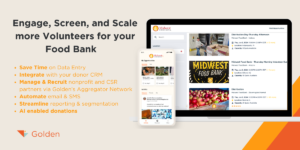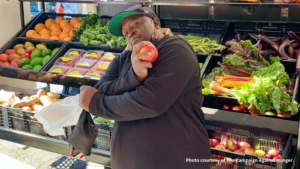At SWIM Consulting we believe the answer is a resounding “Yes!” and we have the data – from more than 1,000 food bank partners – to prove it.
Yes! Food pantries are willing to do new and different things to meet the needs and desires of the people they are currently serving, and those they might be missing. Of the 1,000+ agencies surveyed, 92% are already implementing or willing to implement one or more practices that would make their services more inclusive and equitable.
After engaging with the data, Jennifer Lamplough, Chief Impact Officer at the Northern Illinois Food Bank, said, “I sometimes worry that [the agencies] don’t have the bandwidth to change or try something new, and then when I meet with them and hear about the work they are doing and their willingness to make the work they do even better, I often find myself thinking, ‘Why were you worried?’”
You might say, “Well, maybe the only agencies taking the survey are those with lots of resources.” Please see the chart below to get a breakdown of the pantries surveyed.

If we want to advance equity, where might we need to invest? When we take a closer look at the communities where the most under-resourced agencies are located, it often aligns with where minority populations reside. Although under-resourced, these agencies still want to grow, change and support their neighbors.
Below, you can see responses from a food bank’s agency network. In this example, a vast majority of agencies serving high proportions of minority populations have budgets of less than $50K per year, AND are still ready to serve more neighbors.

Agencies with smaller budgets, like the ones above, might not always show up as top performers because they lack the resources to reach their goals. But data show that is not due to a lack of willingness. Investing in the capacity of these agencies is one way that food banks can advance equity and live-out their neighbor focused strategies.
Where did SWIM Consulting get this data? Over the past three years, in collaboration with multiple Feeding America food banks, SWIM has developed a Network Assessment for food banks to assess their agency network’s willingness to implement what we call Neighbor Centered Practices.
Neighbor Centered Practices refer to a variety of methods that organizations use to match service design with the needs and desires of neighbors. Together, these practices create a more inclusive and equitable model for access.
Through the SWIM Network Assessment, agencies review a list of Neighbor Centered Practices and tell us their level of implementation, interest and resource needs. As you can see from the data below, agencies are ready and willing to implement a variety of practices.

“We have used data from our [SWIM Network Assessment] to better understand our network’s readiness to adopt Neighbor Centered Practices and what are the barriers that may prevent this from happening. Through capacity building grants and agency cohorts, we have been able to address these barriers with our agencies and make meaningful progress towards meeting the needs and wants of our neighbors seeking help.” – Julie Yurko, President and CEO of the Northern Illinois Food Bank
How do we move from interest to action? How do we gain adoption across the network of these Neighbor Centered Practices? Depending on the level of interest and adoption of a certain practice, different supports are necessary to move the network forward. We can’t try to move all the practices at once, and we can’t assume adoption will happen overnight. When we ask food banks how long it took to convince the majority of pantries to consider “client choice,” a common answer is five years.
In the early phases of adopting a neighbor centered practice it is about Inspiring Adoption.
Inspiring Adoption looks like providing resources and experts to answer the questions people are asking right now. Helping organizations engage in a few “quick win” effective actions that advance these practices.
- Support the willing
- Workshops, trainings, 1:1 coaching
- Make network connections to other pantries that have implemented a practice
- Share the stories of progress
- Case studies or videos
- Toolkits, training and experts
Once the network is inspired, and more pantries begin to work towards adoption, it is time to move towards Network Collaboration.
Network Collaboration looks like supporting members in making adaptive changes to culture, power, systems, and policies.
- Support the shared struggle.
- Cohorts
- Accountability Partners
- Agency Conference Sessions
- Release your role as an expert.
- Move into a role as coach/partner vs. teacher
An example of Network Collaboration is the UNITE Cohort at the Northern Illinois Food Bank. Designed with neighbors in the center, it brought together 20 agencies that had shared their willingness to implement more and new Neighbor Centered Practices. Over 6 months the cohort met to support each other in learning more about the neighbors they were missing, and testing out new Neighbor Centered practices. Here are some of the results.

Are you ready to start supporting the food pantries in your network in implementing Neighbor Centered Practices focused on creating a more inclusive and equitable model for access to services?
“When asking our agency network to consider Neighbor Centered Practices, the task can sometimes feel big and ambiguous. SWIM was able to turn the data gathered from our [SWIM Network Assessment] into a story that helped agencies determine where their strengths and areas of opportunity were and how to use that knowledge to make incremental yet impactful change! SWIM’s ability to share our network’s story through data both helped to gain trust with our agencies and ignite change.” — Amanda Krutsch, Agency Training and Development Manager, Northern Illinois Food Bank
SWIM Consulting would love to help you kickstart these efforts. In our work with food banks across the Feeding America Network, we have built and refined tools and processes to help you engage your neighbors and your network in new and innovative ways. Check out our website for more information, and schedule an informational call today.
Heading to the 2023 Feeding America Annual Conference? Find us and say hi!
This article is a sponsored post provided by SWIM Consulting.









